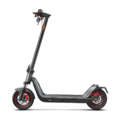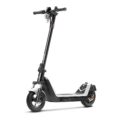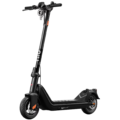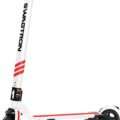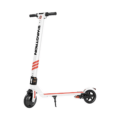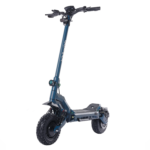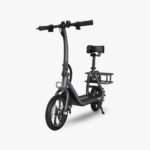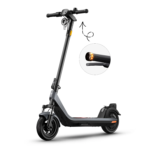- Home
- Scooters
- Electric Scooters
- NIU KQi Youth
NIU KQi Youth
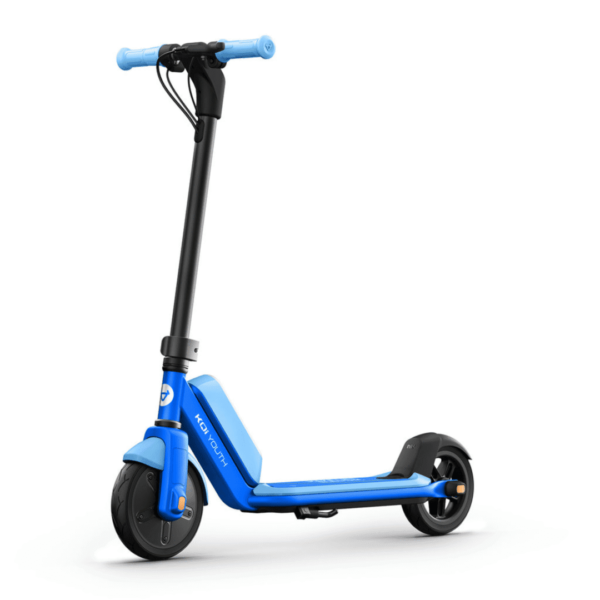

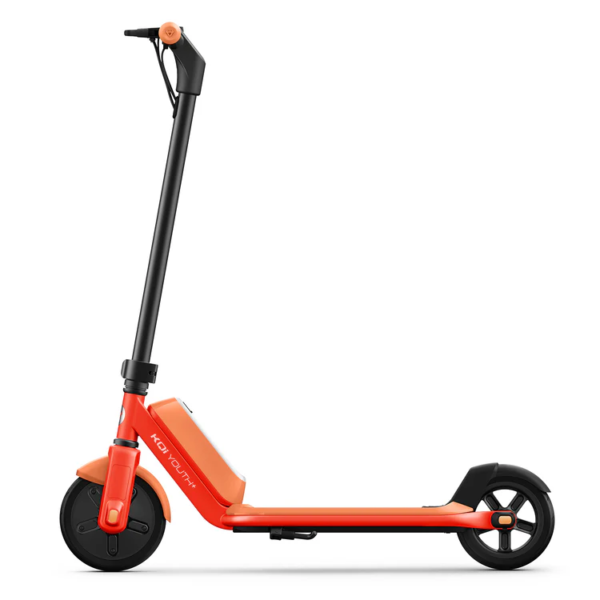
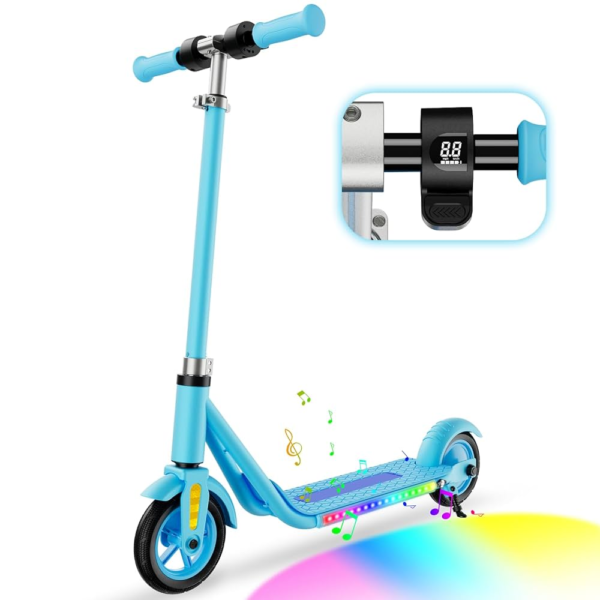
- Battery Range: 7.1 miles / ~70 minutes
- Top Speed: 10 mph (16 km/h)
- Motor Power: 150 W rated
- Weight Capacity: 132 lb (60 kg)
- Charging Time: 4 hours
- Scooter Weight & Portability: ~18.3–18.5 lb (8.3–8.4 kg)
PROS
- Kid-focused speed caps with two modes that grow with skills
- Dual brakes (front electronic + rear foot) teach smooth stopping
- Flat-proof AirStryke tires; no punctures, low maintenance
- Light ring shows battery and boosts visibility; soft stem cover adds safety
- Lightweight and compact; easy to carry and store
CONS
- No dedicated headlight; rely on the light ring and daylight riding
- Non-folding stem means taller storage footprint
- Limited top speed and hill power (by design for safety)
Introduction: A Kid-Friendly Scooter That Puts Safety First
The NIU KQi Youth Specifications describe a compact scooter built for young riders who are ready for their first electric ride. Because kids need a different mix of features than adults, NIU tuned the Youth for safe speed, easy control, and simple upkeep. It uses a 150 W front hub motor with a 200 W peak to keep launch gentle. It also offers two speed modes, so a new rider can start slow and then switch to a higher cap as skills improve. The battery supports about 70 minutes of riding, which aligns well with play sessions, school-yard loops, and neighborhood rides.
Moreover, the package focuses on safety cues kids can understand. The colorful light ring draws attention and shows battery status without small numbers. The soft stem cover protects chests and chins during sudden stops. The front electronic brake and a rear foot brake teach progressive braking without complex levers on both sides. In short, the Youth aims to make early rides fun and calm rather than fast and intense.
Parents also benefit from a simple setup. Because the scooter uses flat-proof solid/PU tires, you avoid punctures. Since the stem is non-folding, there are fewer moving parts to loosen. The size and weight suit kids in the listed age ranges, yet the frame feels sturdy in daily use. Altogether, this scooter brings a careful balance of play, control, and trust.
Who It’s For: Age, Height, and Confidence
The NIU KQi Youth Specifications cover two close variants: Youth and Youth+. The base Youth targets ages 6–12, while the Youth+ fits 8–14 with a height guide around 52″–63″. That spread helps families choose a frame that matches a child’s reach without over-sizing the scooter. Because handlebar height is fixed, picking the right variant matters more than it does on some adjustable kid scooters.
That said, the platform’s design adapts to growth in other ways. First, the two riding modes allow a slow start in Safe. Kids can learn how the throttle behaves, how the scooter rolls over bumpy sidewalks, and how to brake smoothly. Then, once they ride with steady control, Sport unlocks up to 10 mph. In real life, that feels quick in a cul-de-sac, yet it doesn’t overwhelm focus.
Additionally, the deck length and narrow bar width suit smaller bodies. The stance gives enough room for foot swaps, yet it keeps the center of mass low. Because the scooter weighs around 18 lb, most parents can lift and reposition it with one hand. Kids can also push it easily when the battery is off. As a result, the Youth fits casual sessions, park trips, and short school-run hops.
Power and Modes: Gentle Starts, Predictable Pace
Early rides should feel steady, not scary. The Youth’s 150 W motor meets that goal. It eases into motion and builds pace without a surge. In Safe Mode, the cap sits near 6.2 mph. That limit gives new riders time to practice posture, look ahead, and learn smooth turns. It also makes family rides easier because siblings of different ages can still ride together without a speed mismatch.
When a child is ready, Sport Mode raises the cap to 10 mph. The jump is noticeable, yet the throttle mapping still favors control. Because the motor sits in the front wheel, it reacts quickly at low speeds and helps slow the scooter with electronic braking when the rider releases the throttle and taps the lever. That blend of gentle drive and gentle slowdown sets a clear rhythm: accelerate, look ahead, and gradually ease off before corners or crosswalks.
Parents often wonder about hills. The brand does not publish a hill grade for the Youth, and that is sensible. This scooter targets flat streets, mild roll-ups, and driveway ramps. Small inclines are fine; steep climbs will slow progress. That reality is also part of the safety story. The scooter encourages kids to choose safer routes and smoother paths, which is exactly the habit you want them to form early.
Battery and Range: Plenty for Play Sessions
Kids seldom ride for hours at a time. Instead, they ride in bursts: after school, around the block, and back. The Youth’s battery fits that pattern. It supports about 70 minutes of typical use or around seven miles on flat ground. Because most sessions last 20–40 minutes, you can often cover several rides before charging.
Charging itself is easy. The pack refills in roughly four hours, which works well with evening routines. You can plug in after dinner and return to a full charge by morning. Because the system uses a simple 21.6 V battery, there is no complex app to manage. The light ring gives a quick read on battery state, so kids learn to check it before heading out.
Furthermore, the platform avoids the common traps that drain range fast. The solid tire design and low-power motor keep demand consistent. The speed caps prevent energy spikes from hard launches. The scooter does not carry heavy extras, so the motor does not fight unnecessary mass. As a result, range stays predictable across many short rides.
Tires and Ride Feel: Flat-Proof, Kid-Proof
Punctures end playtime fast. To prevent that, NIU uses AirStryke tires with a solid rubber outer and a PU layer for shock absorption. While nothing can erase every bump, this construction softens the sting from sidewalk seams and small cracks. The front wheel is slightly larger at ~7.5″, which helps the scooter roll over shallow obstacles. The rear measures ~7.0″, which suits the mechanical foot brake and keeps the rear of the scooter compact.
Because the tires are flat-proof, you avoid pumps, patch kits, and maintenance fuss. That matters for parents who already manage school bags, snacks, and schedules. The tires also resist age-related softening as there is no inner tube to leak. Consequently, the ride feel remains consistent week after week.
Now, a quick note about expectations. Solid tires will never feel as cushioned as large pneumatic tires, and that is okay here. On a child’s scooter, extra bounce can actually complicate learning. The Youth stays firm enough to teach balance yet soft enough to stay comfortable at the scooter’s modest speeds. Over time, kids learn to relax their knees and pick cleaner lines, which improves comfort even more.
Braking and Control: Two Simple Systems, One Clear Habit
Braking should feel intuitive from day one. The Youth gives kids two tools. First, the front electronic brake slows the scooter the moment they ease off the throttle and squeeze the lever. Because it is electronic, it avoids the sudden “grab” that can pitch weight forward. Second, the rear foot brake adds stopping power when needed. A light press slows the scooter further; a firmer press brings it to a full stop.
This pairing trains a useful habit: look ahead, ease off early, and press down smoothly to finish the stop. As kids gain experience, they also learn how surface changes affect braking. Painted crosswalks, wet leaves, and sand reduce grip. The scooter’s speed caps reduce risk, and the simple brake layout lets riders feel what the surface is doing without a lot of controls to manage.
Steering is equally straightforward. The narrow handlebar suits smaller shoulders and keeps steering light. The deck is long enough for foot swaps, which teaches balance. Because the stem is stiff and non-folding, the front end feels solid when riders push through turns. That firm feel builds confidence and helps limit wobble at speed.
Lights and Visibility: A Fun Feature With a Purpose
Kids love lights, and that can be more than just style. The Youth’s colorful light ring does several jobs. It makes the scooter visible in shade and at dusk. It also displays battery capacity in a way kids can read with a glance. During braking, the ring shifts to a clear pattern that signals slowing.
However, this scooter does not include a full road headlight, and that is an intentional choice. The Youth targets parks, paths, driveways, and short neighborhood loops, not night street rides. If your child will ride in dim light, add reflective clothing and stick to well-lit paths. The scooter’s IP54 rating helps in drizzles, yet families should still avoid heavy rain, puddles, and slick surfaces. That approach keeps rides fun and simple.
Fit and Finish: Small Details That Matter to Families
The Youth feels tidy. The wiring is minimal, the deck grip is firm, and the soft stem cover adds a forgiving surface where it matters. The quick-release vertical tube lets you collapse the bar for storage without a full folding hinge. That design keeps the structure tight and reduces play that can develop in folding joints over time.
Weight stays kid-friendly. At around 18 lb, the scooter is easy to lift into a trunk or move in a hallway. The overall height near 34–39 inches (depending on region/measurement) keeps the scooter close to a kid’s center of mass. As a result, parking and pushing are easy skills to learn on the first day.
Because NIU sells the Youth and Youth+ in multiple regions, colors vary by market. Bright options help visibility and let kids pick a look they enjoy. The box also includes two grip tape patterns, so kids can swap designs or keep a clean spare for later.
Storage and Transport: Home, School, and the Car
Daily life requires simple storage. The Youth’s non-folding stem means you will store it at full height most of the time, though you can quick-release the vertical tube when you need to reduce height. The footprint is small, so closets, garage corners, and mudrooms all work. In apartments, a wall hook or a small floor stand keeps it out of the way.
Car transport is easy. The scooter’s ~34.7″ length fits most trunks diagonally. Because the scooter is light, loading and unloading do not strain backs. For school days, consider a cable lock for brief parking stops, although the Youth does not include an anti-theft system. As always, store the scooter indoors when possible to protect electronics and extend battery life.
Teaching Good Habits: Family Tips That Stick
A kid’s scooter is also a teaching tool. Start with a quiet space, put the scooter in Safe Mode, and talk through a few basics: stance, looking ahead, and gentle braking. Because speed is capped, kids can practice turns without fear. After a few sessions, switch to Sport Mode and repeat the same course. They will feel the added speed but also see how the same calm habits still work.
Use the light ring to build a battery routine. Before each ride, ask your child to check the light and tell you if it shows a high or low level. At the end of a session, plug in the charger together. Small rituals like these form early care habits that carry into bikes, boards, and, eventually, cars.
Set clear ride zones and time limits. Sidewalk loops, park paths, and empty cul-de-sacs keep rides smooth. Save busy streets for adult scooters. And always use protective gear: a proper helmet, closed-toe shoes, and, when learning, knee and elbow pads. As confidence grows, pads may come off, but helmets should stay on every ride.
Maintenance: Light, Quick, and Low-Stress
The Youth minimizes maintenance. Solid/PU tires eliminate flats. The electronic front brake avoids pad swaps. The rear foot brake is a simple molded part with long service life. Routine care focuses on the basics: wipe dust, check the deck grip, and confirm that the quick-release and axle nuts are tight.
Charging habits matter too. Because the battery is small, avoid deep discharges. Regular top-ups keep the pack healthy and ensure the scooter is ready when the weather turns nice. Store the scooter indoors, away from heat sources, and charge on a hard surface. Teach kids to respect the charger and to keep cords tidy and out of the way.
If something feels loose, address it early. A little play in the quick-release or a rattly accessory will not fix itself. Tightening a fastener or reseating the stem takes minutes and prevents wear over time. These simple checks also show kids that caring for gear is part of the fun.
How It Compares: Youth vs. Youth+, and Against Other Kids’ Scooters
Within NIU’s range, Youth vs. Youth+ mainly differs by recommended age/fit. The core NIU KQi Youth Specifications—motor rating, speed caps, tire system, brakes, and water protection—remain the same idea: safe speeds, flat-proof tires, and simple controls. If your child is on the taller side, Youth+ often fits better due to the age/height guidance.
Against other kids’ scooters, the Youth stands out with its light ring, dual brakes, and flat-proof tire design. Many rival models use tiny solid tires that feel harsh and lack a clear battery indicator. Others skip a front electronic brake, which reduces smoothness when slowing. Some competitors include app features, but for younger kids, no-app simplicity keeps focus where it belongs—on the path ahead.
Parents comparing to teen-oriented scooters should also consider context. Models for teens go faster, weigh more, and require stronger braking skills. Those designs suit older riders with more road awareness. For the 6–12 or 8–14 bracket, the Youth hits a smarter target: enough speed to feel exciting but not enough to invite risky behavior.
Value: What You’re Really Buying
On paper, the Youth may look basic compared with adult commuter scooters. Yet that is its strength. You are buying fit, safety, and low-stress ownership. The scooter starts reliably, charges quickly, and rolls without flats. Kids learn to ride with two simple modes and two simple brakes. Parents skip the heavy maintenance and the constant fear of pinch flats. The price usually sits below adult models, which makes sense for a first scooter.
Longevity also adds value. The frame is tough, the parts list is short, and the tires cannot puncture. After one child outgrows the Youth, a younger sibling can step in—with a new grip tape pattern for a fresh look. In many families, that hand-me-down path stretches an initial purchase over several years of active use.
Final Verdict
The NIU KQi Youth Specifications point to a clear mission: make a child’s first electric scooter safe, simple, and fun. With 150 W of gentle power, two ride modes, dual brakes, and flat-proof tires, it gives kids room to learn without pushing them into speeds they cannot manage. The colorful light ring adds visibility and turns battery checks into a game. The non-folding stem keeps the chassis solid and quiet. Charging is quick, storage is easy, and upkeep is minimal.
If your child wants a scooter for neighborhood rides, parks, and school-yard laps, the NIU KQi Youth is a strong choice. Choose Youth+ for taller kids, start in Safe Mode, and build skills step by step. For a first e-scooter that balances smiles and safety, this is exactly the point.
Specifications
General
| Model The Model specifies the exact version or name of the scooter. It helps identify its unique design, features, and specifications within the manufacturer’s product line. Knowing the model makes it easier to compare options, find compatible accessories, or look up support information. | KQi Youth |
| Brand The Brand identifies the manufacturer or company that designs and produces the scooter. A trusted brand is a sign of quality, reliability, and good customer support. Well-known brands often have higher standards for safety, performance, and after-sales service, giving you more confidence in your purchase. | NIU |
| Release Date The Release Date indicates when the scooter model was officially launched on the market. This helps you know how current the design, technology, and features are. A newer release date often means updated components, improved performance, and the latest safety or smart features. | 01 January 2025 |
| Recommended Age Recommended Age indicates the minimum age range that the scooter is designed for, based on safety, size, and ease of use. Following the recommended age helps ensure that riders can handle the scooter’s speed, weight, and controls comfortably and safely. Always check local laws and use protective gear, especially for younger riders. | Youth: 6–12; Youth+: 8–14 (height guidance: 52″–63″ for Youth+) |
Performance & Power
| Motor Power (Wattage) What it means: The motor power, measured in watts (W), shows how strong the scooter’s electric motor is. Why it matters: Higher wattage usually means better acceleration, more torque, and improved performance on hills or rough terrain. For example, a 250W motor is good for flat city roads and light riders, while a 500W or 1000W motor provides more power for faster speeds or climbing steep inclines. | 150 W rated, up to 200 W max |
| Top Speed The Top Speed indicates the maximum speed that the scooter can reach under optimal conditions. It’s usually measured on level ground with a fully charged battery and an average rider weight. A higher top speed allows you to travel longer distances faster, but always ensure you ride within legal speed limits and your personal comfort zone for safety. | Safe Mode: up to 6.2 mph (10 km/h); Sport Mode: up to 10 mph (16 km/h) |
| Battery Capacity Battery Capacity refers to the total amount of energy the scooter’s battery can store, usually measured in ampere-hours (Ah) or watt-hours (Wh). A higher battery capacity means you can ride longer distances on a single charge, reducing the need for frequent recharging. Keep in mind that actual range can vary depending on rider weight, terrain, speed, and weather conditions. | ≈67 Wh (21.6 V lithium) |
| Estimated Range per Charge The Estimated Range per Charge indicates the average distance the scooter can travel on a single full battery charge. This range is calculated under optimal conditions, such as flat terrain, moderate speed, and average rider weight. Real-world range may vary depending on riding style, terrain, weather, and load. A longer range means fewer recharges and greater freedom for longer trips. | up to 7.1 miles / ~70 minutes ride time |
| Hill Climb Ability Hill Climb Ability describes the maximum incline or slope that the scooter can handle while maintaining stable performance. It’s typically expressed as a percentage or in degrees. A higher hill climb rating means the scooter can tackle steeper hills without losing too much speed or power. Actual climbing performance may vary based on rider weight, battery charge, and terrain conditions. | Not specified by manufacturer |
| Drive System The Drive System refers to how power from the motor is delivered to the wheels. Electric scooters typically use either a hub motor (directly integrated into the wheel) or a chain/belt drive system. A high-quality drive system ensures smooth acceleration, efficient power transfer, and low maintenance. The choice of drive system affects performance, noise level, and overall ride experience. | Front-wheel drive hub motor (front electronic brake) |
Charging & Electrical
| Charging Time Charging Time indicates how long it takes to fully recharge the scooter’s battery from empty to 100% using the standard charger provided. Faster charging means less downtime and more time on the road. Actual charging time may vary slightly depending on battery capacity, charger output, and environmental conditions. | ~4 hours (official); some retailers list ~5 hours |
| Battery Type Battery Type refers to the specific technology used in the scooter’s battery, which affects performance, lifespan, weight, and charging time. Most modern electric scooters use high-quality lithium-ion (Li-ion) batteries because they offer a good balance of energy density, durability, and low maintenance. A reliable battery type ensures consistent power delivery and longer riding ranges. | 21.6 V lithium-ion with NIU BMS protections |
| Removable Battery A Removable Battery means the battery pack can be easily detached from the scooter for convenient charging and replacement. This feature allows you to charge the battery separately, swap it with a spare for extended range, or securely store it indoors in extreme weather. Removable batteries add flexibility and make it easier to keep your scooter powered up wherever you are. | No |
| Regenerative Braking Regenerative Braking is an energy-saving feature that converts some of the energy normally lost during braking back into battery power. When you slow down or brake, the motor works in reverse to generate electricity, which helps extend the scooter’s range and improves overall efficiency. This system also reduces wear on traditional brake components, leading to lower maintenance over time. | Yes |
| Lighting Lighting refers to the built-in front and rear lights that enhance visibility and safety when riding in low-light conditions or at night. Good lighting helps you see the road ahead and ensures that other road users can see you. Many scooters include LED headlights, taillights, and sometimes brake lights or side reflectors for added safety and compliance with local traffic regulations. | Colorful ambient light ring with multiple riding light options, battery indication, and brake lighting (no dedicated headlight) |
Build & Dimensions
| Scooter Weight Scooter Weight refers to the total weight of the scooter when fully assembled, including the battery. This affects how easy it is to carry, lift, and store the scooter when not in use. A lighter scooter is more portable and convenient for commuting, especially if you need to carry it upstairs or onto public transport. Keep in mind that a sturdy frame and quality components may add to the weight but also contribute to better durability and ride stability. | ~18.3–18.5 lb (8.3–8.4 kg) |
| Maximum Rider Weight Maximum Rider Weight indicates the highest rider weight that the scooter is designed to safely support while maintaining optimal performance and stability. Staying within this limit helps ensure reliable acceleration, braking, and climbing ability, and it protects the frame, suspension, and motor from excessive strain. Exceeding the recommended limit may reduce performance and increase wear on components. | 132 lb (60 kg) |
| Deck Size Deck Size refers to the dimensions of the scooter’s standing platform. A wider and longer deck provides more foot space, allowing you to stand comfortably and adjust your stance while riding. A well-sized deck improves balance and stability, especially on longer rides or at higher speeds. Compact decks, on the other hand, help keep the scooter lightweight and portable. | 15.7″ × 4.3″ (L × W) |
| Handlebar Height Handlebar Height refers to the distance from the deck to the handlebars, which affects your riding posture and comfort. An appropriate handlebar height helps you maintain good balance, reduces strain on your back and arms, and makes steering more comfortable. Some scooters have adjustable handlebars to fit riders of different heights, while others have a fixed height for a streamlined design. | ~34.6″ (overall height 880 mm) |
| Folding Mechanism The Folding Mechanism describes how easily and securely the scooter can be folded for carrying and storage. A well-designed folding system lets you quickly collapse the scooter into a compact size, making it convenient to transport on public transit, store under a desk, or fit into a car trunk. Look for sturdy latches and safety locks to ensure the scooter stays firmly in place when folded or unfolded. | No |
| Dimensions Folded Dimensions indicate the size of the scooter when it’s fully folded. This measurement shows how much space the scooter will take up when stored or carried, making it easier to check if it will fit in your car trunk, under a desk, or in a closet. Compact folded dimensions are ideal for commuters who need to bring their scooter on public transport or store it in tight spaces. | Not applicable (non-folding); overall size (L × W × H): 881.5 × 110 × 880 mm (34.7″ × 4.3″ × 34.6″) for storage reference |
| Material Material refers to the primary construction materials used for the scooter’s frame and key components. High-quality materials like aircraft-grade aluminum, reinforced steel, or durable composites provide strength, stability, and a lighter overall weight. A sturdy material ensures the scooter can handle daily wear and tear while maintaining safety and performance. | Not specified by manufacturer (metal frame with polymer covers) |
Safety & Control
| Brake Type(s) Brake Type(s) describe the braking systems the scooter uses to help you slow down or stop safely. Common brake types include mechanical brakes (like drum or disc brakes), electronic brakes, and foot brakes. Many scooters combine multiple braking systems for added safety and shorter stopping distances. The type and quality of brakes affect your control, especially when riding at higher speeds or on slopes. | Front electronic (regen) + rear mechanical foot brake |
| Suspension Suspension refers to the system that absorbs shocks and vibrations while riding, providing a smoother and more comfortable ride over uneven or rough surfaces. Scooters may have front suspension, rear suspension, or dual suspension for better shock absorption and stability. Good suspension helps reduce rider fatigue and improves control, especially when riding on bumpy roads or off-road paths. | None (comfort via tire construction) |
| Tire Type Tire Type refers to the kind of tires the scooter uses, which directly affects ride comfort, traction, and maintenance. Common types include solid (airless) tires, pneumatic (air-filled) tires, or hybrid options. Pneumatic tires offer better shock absorption and a smoother ride on rough surfaces, while solid tires are puncture-proof and require less upkeep. The right tire type helps ensure safe handling and a comfortable ride in different conditions. | Solid rubber + PU “AirStryke” (flat-proof, shock-absorbing) |
| Tire Size Tire Size indicates the diameter and width of the scooter’s tires, which affect ride comfort, stability, and how well the scooter handles different terrains. Larger tires generally offer better shock absorption and a smoother ride over bumps and rough surfaces, while smaller tires keep the scooter lighter and more portable. Choosing the right tire size helps ensure a balance between agility and comfort. | Front: 191 × 38 mm (~7.5″ × 1.5″); Rear: 178 × 38 mm (~7.0″ × 1.5″) |
| Kickstand The Kickstand is a built-in stand that allows you to park your scooter upright when it’s not in use. A sturdy kickstand keeps the scooter stable and prevents it from tipping over, protecting it from scratches and damage. It also makes storing and accessing your scooter more convenient, whether you’re at home, work, or on the go. | Yes |
| Water Resistance Rating Water Resistance Rating indicates how well the scooter is protected against water and moisture, usually shown as an IP (Ingress Protection) rating. This rating helps you understand whether the scooter can handle light rain, splashes, or wet roads without damage. While most scooters are not fully waterproof, a good water resistance rating adds peace of mind when riding in changing weather conditions. Always avoid deep puddles or submerging the scooter to protect its electrical components. | IP54 |
Features & Extras
| Display/Console The Display (or Console) shows important real-time information about your ride, helping you monitor your scooter’s status at a glance. Typical displays show speed, battery level, distance traveled, and riding mode. Some models also include additional features like Bluetooth connectivity, app integration, or backlighting for better visibility at night. A clear and easy-to-read display enhances safety and convenience on every trip. | Light ring shows battery status and ride effects; no speedometer |
| Ride Modes Ride Modes refer to the different speed and power settings you can choose to match your riding style or road conditions. Common modes include eco for maximum range and energy efficiency, standard for everyday balance, and sport or turbo for higher speed and stronger acceleration. Switching between ride modes allows you to customize performance, conserve battery, and ride safely in various environments. | 2 modes: Safe and Sport |
| Smart App Connectivity Smart App Connectivity lets you pair your scooter with a dedicated mobile app via Bluetooth. Using the app, you can monitor real-time ride stats like speed, battery level, and range, adjust settings such as ride modes or cruise control, lock the scooter for added security, and sometimes receive firmware updates. This feature adds convenience and allows you to personalize your riding experience right from your smartphone. | No |
| Anti-Theft System The Anti-Theft System helps protect your scooter from unauthorized use or theft. This feature can include built-in alarms, electronic motor locks, GPS tracking, or remote locking through a mobile app. A good anti-theft system provides peace of mind when parking your scooter in public spaces, adding an extra layer of security to safeguard your investment. | None |
| Cruise Control Cruise Control allows you to maintain a steady speed without continuously holding the throttle. This feature makes longer rides more comfortable by reducing hand fatigue and providing a smoother, more relaxed riding experience — especially on flat, open roads or bike lanes. For safety, cruise control can usually be easily activated or deactivated while riding. | No |
| Accessories Included Accessories Included lists the additional items that come with the scooter to enhance your riding experience and convenience. Common accessories may include a charger, kickstand, bell, lights, phone holder, or carrying strap. These extras add value by making your scooter safer, easier to use, and ready to ride straight out of the box. | Charger; swappable grip tape patterns (box includes two) |
Warranty & Compliance
| Warranty Period The Warranty Period indicates how long the manufacturer guarantees the scooter against defects in materials and workmanship under normal use. A good warranty provides peace of mind, showing the brand’s confidence in its product quality. Always check what parts are covered, such as the frame, battery, and motor, and follow the maintenance guidelines to keep your warranty valid. | Standard NIU regional warranty (varies by market) |
| Certifications Certifications confirm that the scooter meets specific safety, quality, and environmental standards set by recognized organizations or regulatory bodies. Common certifications may include CE, RoHS, UL, or other local compliance marks, depending on your region. These certifications ensure that the scooter is manufactured to high standards and is safe and legal to use in your country. | UL2271 (battery) compliance noted by major US retailer; IP54 ingress rating |


